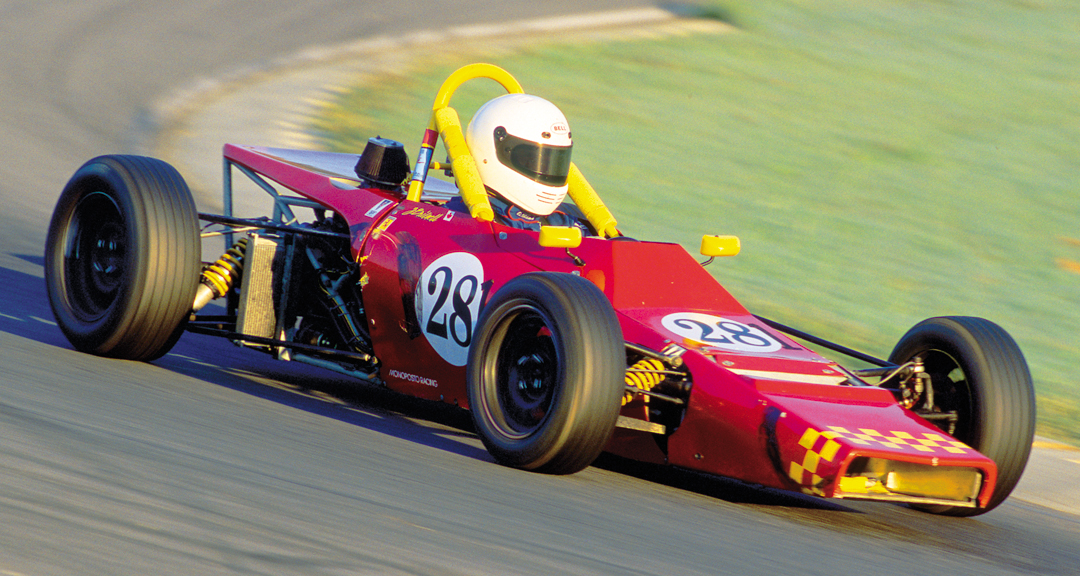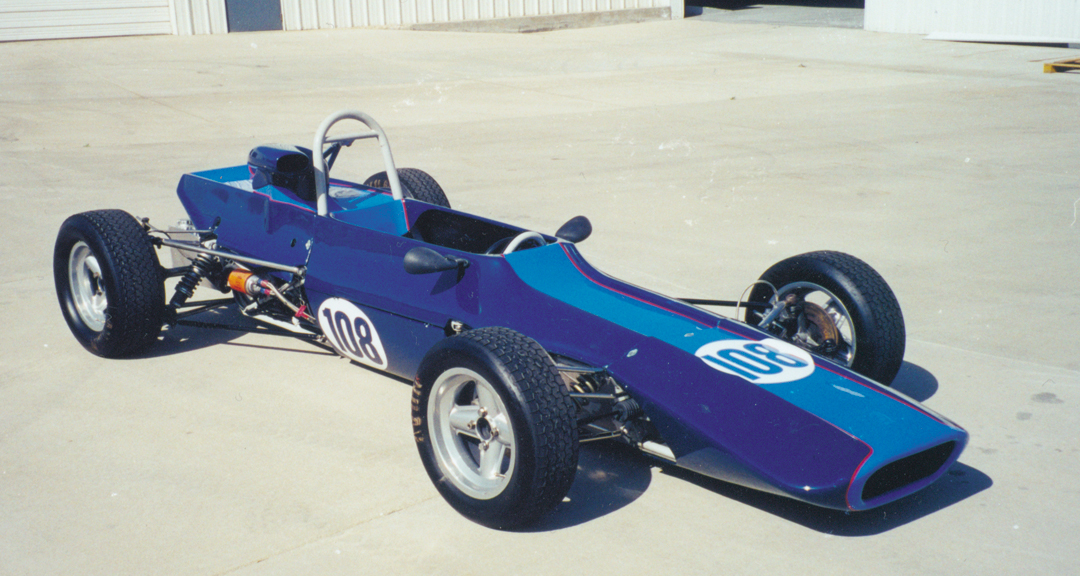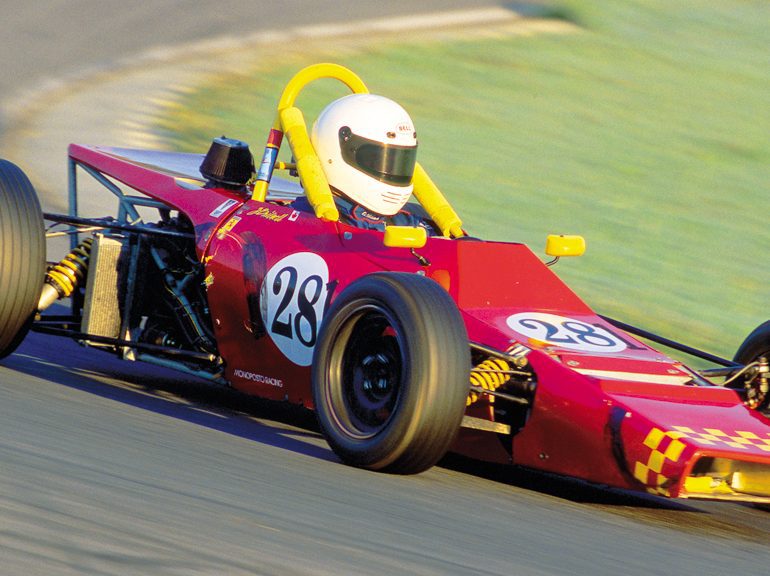Formula Ford was a specification racing series created on the idea that the best drivers would win if they were racing identical cars. The idea for this low-budget Formula was created by an Englishman named Geoffrey Clarke, who had a driver’s school called Motor Racing Stables, based at the Brands Hatch Circuit. Clarke received support from Ford’s competition manager, Henry Taylor, and Ford’s director of public affairs, Walter Hayes. Ford supplied its 1,600-cc Cortina GT engine, as well as their backing and name. Lotus Components built a car based on the Lotus 31 Formula Three car, calling it the Lotus 51 Formula Ford. Ironically, these early cars had a Renault gearbox. They sold for the affordable price of just under £1,000, making racing in this series very affordable as a Formula Three car of the day cost over £3,000. The Royal Automobile Club, Britain’s governing body, established a set of racing regulations. The first official race was held at Brands Hatch on July 2, 1967. From 1967 to the present, the Formula Ford Series has produced some very exciting racing in many different makes of racing cars, as well as some great drivers and future champions, including Andretti, Fittipaldi, Schenken, Scheckter and Senna. Today historic Formula Ford is an entry-level racing category and, for the purposes of this guide, covers cars from 1967 to 1972. Keep in mind the greatest single factor in determining the value of a Formula Ford is the quality and cost of its preparation.
| Make | Model | Level III | Level II | Level I |
| Alexis | 15 | $8,000 | $12,000 | $18,000 |
| 18, 22 | $6,000 | $10,000 | $15,000 | |
| Bobsy | $5,000 | $10,000 | $15,000 | |
| Caldwell | D9, D9B | $8,000 | $12,000 | $18,000 |
| Crossle | 16F | $8,000 | $12,000 | $17,000 |
| 20F | $8,000 | $12,000 | $18,000 | |
| Dulon | LD4, 4B, 4C | $7,000 | $10,000 | $16,000 |
| LD9 | $8,000 | $12,000 | $18,000 | |
| Elden | PH8 | $10,000 | $12,000 | $16,000 |
| PH10 | $10,000 | $14,000 | $18,000 | |
| Ginetta | G-18 | $8,000 | $12,000 | $16,000 |
| Hawke | DL2, 2A, 2B | $10,000 | $14,000 | $19,000 |
| DL9, 9A | $12,000 | $15,000 | $21,000 | |
| LeGrand | Mk 10 | $5,000 | $10,000 | $15,000 |
| Lola | T200 | $10,000 | $14,000 | $18,000 |
| T202 | $10,000 | $16,000 | $20,000 | |
| T204 | $10,000 | $16,000 | $20,000 | |
| Lotus | 51 A,B,C | $12,000 | $20,000 | $25,000 |
| 61M, MX | $10,000 | $15,000 | $18,000 | |
| 69 | $25,000 | $30,000 | $35,000 | |
| Macon | MR 7B | $5,000 | $10,000 | $14,000 |
| MR8, 8B | $5,000 | $10,000 | $14,000 | |
| March | 709, 719, 729 | $10,000 | $14,000 | $18,000 |
| Merlyn | MK11, 11A | $15,000 | $20,000 | $25,000 |
| MK17, 17A | $10,000 | $15,000 | $20,000 | |
| MK20, 20A | $12,000 | $18,000 | $24,000 | |
| Royale | RP2 | $6,000 | $10,000 | $16,000 |
| RP3, 3A | $8,000 | $12,000 | $18,000 | |
| Tecno | FF | $10,000 | $15,000 | $20,000 |
| Titan | MK 6,6A,6B,6C | $15,000 | $20,000 | $25,000 |
| Winkelman | WDF1,2,3,4 | $10,000 | $15,000 | $20,000 |
1969 Hawke DL2 or 1972 Hawke DL9

The British Hawke racing car company was founded in 1968 by David Lazenby, Jim Clark’s mechanic at Indianapolis, and a former principal of Lotus Components during the beginning of the Formula Ford era. Lazenby believed that he could build a better car and designed the DL1-2, with which Tom Walkinshaw won the 1969 Scottish Formula Ford Championship. In 1972 the DL2 won the USA SCCA National Championship. Hawke went on to produce the DL9, with which Syd Fox won the 1972 British Sunbeam Electric Formula Ford Championship. Rupert Keegan drove for Hawke and hired a young Adrian Reynard to help design the DL15, with which Stuart Lawson won the 1976 Scottish Formula Ford Championship. However, Hawke over-expanded into other Formula and subsequently closed its doors in 1979.
1972 Titan 6B or 1970 Titan Mark 6

Criteria Used For Assessing Valuations for this Guide:
- Degree of Originality
- Overall Condition, Restoration
- Technology, Design, Coachbuilder
- Production Numbers/Rarity
- Competition History
- Ownership History, Documentation
- Modern Event Eligibility
Regional Variances
The prices stated in this guide are based on U.S. values. The values of historic racing cars can vary as much as 25%-35% in other countries, depending on local market appeal, currency rates, import duties, and VAT. Most of the time, we are able to document known sales or closed escrows, as they say in real estate. When this is not possible, a logical estimate of the car’s value is given, based on its sales history and relationship to cars of its type.
The prices stated in this guide are based on U.S. values. The values of historic racing cars can vary as much as 25%-35% in other countries, depending on local market appeal, currency rates, import duties, and VAT.
LEVEL |
VALUATION CATEGORIES |
|---|---|
I |
The best combination of all criteria. |
II |
Satisfies mid-range of criteria. |
III |
In need of restoration. Meets only a few points of criteria |




